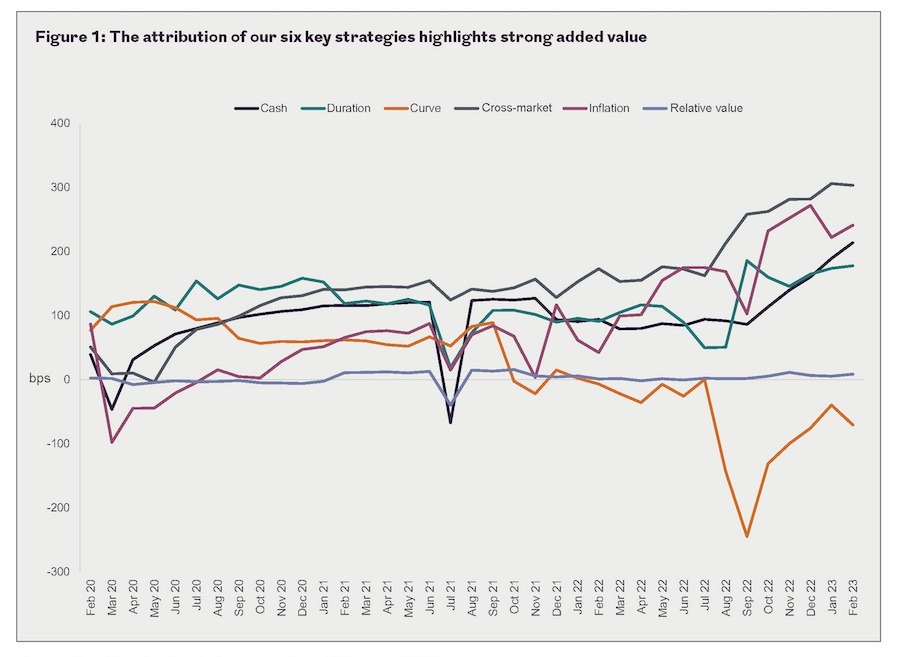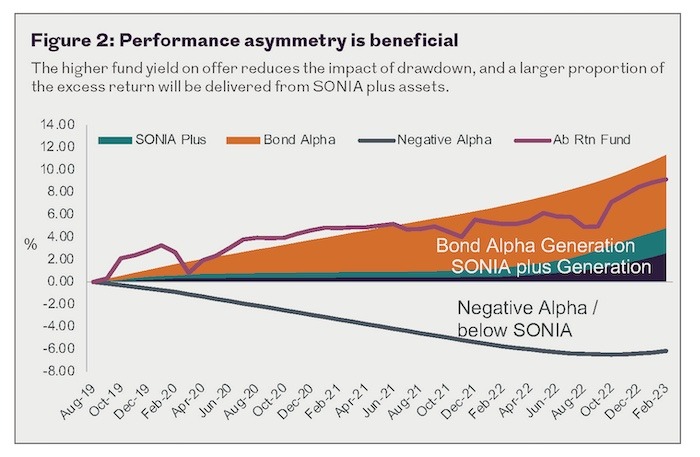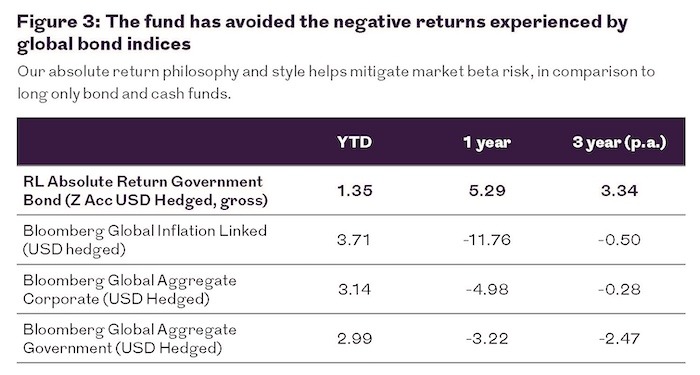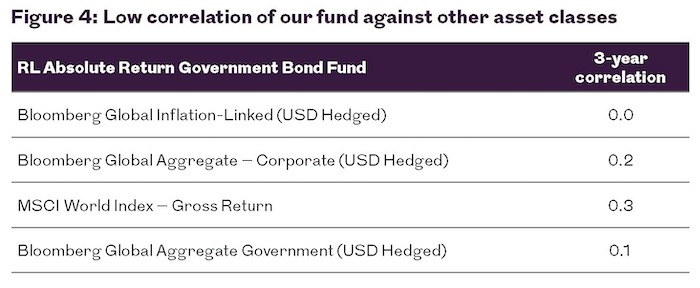By Craig Inches, Head of Rates and Cash at Royal London Asset Management
Inflation is the bond market’s worst enemy
Inflation was notable by its absence in the wake of the financial crisis. Global central banks cut interest rates and pumped excess liquidity into the system via quantitative easing in a desperate attempt to stoke an inflationary fire. This exercise appeared futile, until the combination of the Covid pandemic and the Ukraine war sparked the embers of what has now become an inflationary inferno. Supply chain disruption and domestic onshoring (of defence and energy), combined with tight labour markets, has seen global interest rates skyrocket as global central banks try to douse the flames with a disinflationary hose.
This rise in interest rates has resulted in capital deterioration within investor portfolios as historically low bond yields were insufficient to offset the magnitude of the drawdown experienced as yields rose. There was almost no shelter as government, inflation-linked and corporate bonds all suffered a similar fate. Only money market funds provided an element of safe haven, although allocations to this asset class were limited due to the very low yields on offer.
Absolute return funds should have been the key benefactor in a rising rate environment: theoretically, these funds are non-correlated with market beta and are free to deliver a positive absolute return whatever the macroeconomic conditions. However, many investors found that this was not the case and a number of funds in this sector have experienced returns that echoed those of a bond fund. This is not the first time this has happened and over the years these outcomes have given the sector a bad name. However, is this the fault of the sector and the available products or perhaps the mindset of the managers who manage these strategies?
How should an Absolute Return Government bond fund be structured and managed?
Many managers think about Absolute Return in a long-only context. What do I mean by this? The manager constructs a portfolio of bonds that they believe will outperform a cash benchmark over time. The problem with this approach is that it embeds significant interest rate risk and or credit risk into the portfolio and therefore, the absolute return of the portfolio is most likely determined purely by the direction of interest rates or credit spreads. If an investor wants exposure to rate moves or credit spreads, then they should just buy a plain vanilla government or corporate bond fund.
In our opinion an absolute return strategy should focus on providing an excess return over and above a cash rate in all market conditions. To achieve this the manager must keep interest rate and credit risk to a minimum and focus on delivering outperformance from a range of non-correlated diversified market neutral strategies.
At Royal London Asset Management, we run a range of sovereign funds, both nominal and inflation linked. These funds are benchmarked against underlying published bond indices and by utilising these multiple diversified active strategies, managed in a risk-aware style, accounting for volatility and market direction, we can add incremental outperformance regardless of market direction. The best ideas approach that we apply to our long-only benchmarked funds is replicated in our Absolute Return strategy using a combination of assets as well as a derivative overlay strategy. In effect this portable alpha technique allows our clients to experience the same outperformance captured within our bond range but instead supplemented by a cash-based return.
Our toolkit consists of six key strategies:
• Cash: Utilising money market instruments, secured credit and supranational bonds we can enhance portfolio yield by owning these low-risk SONIA plus assets.
• Duration: Central banks are likely to remain more reactive and flexible with their monetary policy toolkit, leading to greater volatility in the level of yields. We can take a long or short duration stance to capitalise on these moves.
• Curve: Greater monetary policy flexibility and changing supply/demand dynamics will lead to greater volatility in the shape of the yield curve. We can overweight or underweight certain parts of the yield curve dependent on these known outcomes.
• Cross-market: Central banks’ monetary policy and supply profiles may diverge more over the coming decade, creating numerous cross-market trading opportunities. We can underweight bonds in one country versus another on a hedged basis to add value from spread moves.
• Inflation: The debate around hard versus soft landings, tight labour markets and geopolitical risks will lead to changing inflationary expectations and greater volatility in inflation breakevens. We can switch nominal bonds into index linked bonds or vice versa to reflect our inflation view.
• Relative value: Quantitative Tightening (QT) sales by central banks and heightened volume of supply will increase the opportunities available to trade the relationship between specific bonds along the yield curve.

Source: Royal London Asset Management as at February 2023. Past performance is not a guide for future performance. Portfolio characteristics and holdings are subject to change and without notice. This does not constitute an investment recommendation. For information purpose only.
The unfolding environment has never been better for an active manager in the sovereign bond space, and we see the following strategic and tactical opportunities persisting for several years:
Strategic (longer-term)
• Macro data surprises continuing to drive interest rate volatility and fiscal policy moves
• Geopolitical uncertainty impacting yield differentials and asset returns
• De-globalisation / onshoring themes raising inflation expectations
Tactical (shorter-term)
• Excess and frequent global bond supply and demand events (auctions and index changes)
• Central banks moving from buyers to sellers will increase the number of supply events (QE to QT)
• Changes to pension fund strategy creating bond volatility via restructuring
The objective of the fund
The objective of the RL Absolute Return Government Bond Fund (the ‘fund’ or the ‘portfolio’) is to target absolute positive capital growth. The portfolio seeks to outperform its benchmark (SONIA) by 2.5% per annum over rolling three-year periods and aims for positive performance over rolling 12-month periods. To achieve this the fund invests in a diversified portfolio of global government bonds and short dated investment grade credit utilising a derivative overlay focusing on our six key alpha strategies. With a longer-term philosophy, driven by a strong risk management process, the fund seeks to achieve the performance with low volatility and minimal drawdowns, whilst maintaining high liquidity and low correlation to bond markets and other asset classes.
Performance, attribution and correlation of the fund
Looking at fund performance over the medium-term highlights how our process of adding incremental performance in a low volatility style has proved beneficial throughout both the zero interest rate years as well as the recent period of extreme volatility.

Source: Royal London Asset Management as at February 2023. Past performance is not a guide for future performance.
Figure 3: The fund has avoided the negative returns experienced by global bond indices
Our absolute return philosophy and style helps mitigate market beta risk, in comparison to long only bond and cash funds.

Source: Royal London Asset Management and Bloomberg as at 31 March 2023. Past Performance is not a guide to future performance. The value of investments and the income from them is not guaranteed and may go down as well as up and investors may not get back the amount originally invested. The impact of fees or other charges including tax, where applicable, can be material on the performance of your investment.

Source: Royal London Asset Management, Bloomberg and MSCI as at 31 March 2023.
Purpose and benefit of Absolute Return within a balanced mandate
We believe that the following characteristics should be considered when choosing an Absolute Return manager.
• Uncorrelated returns: Aim to deliver a positive return in all market conditions with limited beta/correlation.
• Diversification: Numerous strategies (Cash, Duration, Curve, Cross-market, Inflation and Relative value) employed to deliver diverse sources of risk adjusted alpha, aiding repeatability, and limiting drawdown.
• Low volatility: Low market beta combined with diversified alpha sources helping to minimise market shocks and reduce overall volatility relative to fixed income markets.
• Liquidity: A strategy with high liquidity by design can fulfil an important role as part of a liquidity waterfall or aide asset allocation decisions.
• Stability: Source a stable and experienced government bond team with a proven track record.
Why Royal London Asset Management
Royal London Asset Management’s Government Bond team averages over 20 years’ investment experience and have worked together for over 10 years delivering strong performance through several market cycles including the Great Financial Crisis, Covid-19 pandemic, and the pension fund liquidity crisis.
We have developed a repeatable investment approach that combines research and portfolio construction to support strategic and tactical positioning across these six diversified strategies in a risk-controlled manner. This allows us to successfully achieve the objective of consistent and incremental outperformance across our range of funds.
The techniques used within our range of long only funds are used to the same effect within the Absolute Return strategy. This allows us to create a ‘portable alpha’ source that can be successfully applied to any underlying benchmark.
Past performance is not a guide to future performance. The value of investments and any income from them may go down as well as up and is not guaranteed. Investors may not get back the amount invested. The views expressed are those of the author at the date of publication unless otherwise indicated, which are subject to change, and is not investment advice.
Royal London Asset Management has partnered with FundRock distribution S.A, who will distribute RLAM’s products and services in the EEA. This follows the United Kingdom’s withdrawal from the European Union and ending of the subsequent transition period, as UK Financial Services firms, including Royal London Asset Management, can no longer passport their business into the EEA.
For more information contact: info_frd@fundrock.com
For professional clients only, not suitable for retail investors. This is a marketing communication.
This is a financial promotion and is not investment advice. Telephone calls may be recorded. For further information please see our Privacy policy at www.rlam.com.
The views expressed are those of the author at the date of publication unless otherwise indicated, which are subject to change, and are not investment advice.
Issued in May 2023 within Europe (ex-Switzerland) by FundRock Distribution S.A. (“FRD”) the EU distributor for Royal London Asset Management Limited. FRD is a public limited company, incorporated under the laws of the Grand Duchy of Luxembourg, registered office at 9A, rue Gabriel Lippmann, L-5365 Munsbach, Luxembourg, and registered with the Luxembourg trade and companies register under number B253257. Page 23, FRD is authorized as distributor of shares/units of UCIs without making or accepting payments (within the meaning of Article 24-7 of the 1993 Law), as updated from time to time. FRD is authorised and regulated by the Commission de Surveillance du Secteur Financier (CSSF). Portfolio management activities and services are undertaken by Royal London Asset Management Limited, 80 Fenchurch Street, London, EC3M 4BY, UK. Authorised and regulated by the Financial Conduct Authority in the UK, firm reference number 141665. A subsidiary of The Royal London Mutual Insurance Society Limited.



